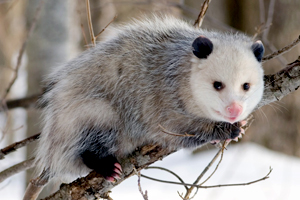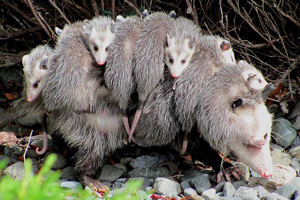Native Wildlife: Opossum

Opossum; photo by Cody Pope, CC BY-SA 2.5
Lurking in backyards around Maryland is an unsung hero: the Virginia opossum. With its rat-like tail and 50-tooth grin, the Virginia opossum isn’t always revered. However, recent research from the Cary Institute of Ecosystem Studies has indicated the Virginia opossum as an important tick predator, grooming off and consuming almost 4,000 ticks per week! In contrast, species like eastern cottontails and deermice tend to leave ticks on their body. If that isn’t cool enough, a peptide in opossum blood can neutralize snake venom, allowing the opossum to dine on venomous snakes. Researchers are working to utilize this peptide as an antidote for snakebite victims.
Virginia opossums are the only marsupial in the United States. These pouched mammals breed between January and July. They have a short gestation period and give birth to lima bean-sized young which develop in the female’s pouch. The young live and nurse in the mother’s pouch for two months. When they leave the pouch, the female will often carry them on her back.
Opossums are omnivores and are great for gardeners. They eat a varied diet of insects, worms, snails, slugs, frogs, birds, fruits, nuts and carrion (dead animals) as well as small rodents, voles, shrews and moles. Opossums are often seen feeding at compost piles, garbage cans and bird feeders.

Opossum with young; photo by Specialjake, CC BY-SA 3.0
Opossums make few sounds. Sometimes, they will hiss or make a slight growl if they feel threatened or during fights in the mating season. Females will also make a clicking noise to their young and the young, if separated from their mother, will make a slight “choo choo” call or a sneezing noise to communicate. Opossums use several techniques to avoid predators. In one technique, they will freeze to avoid being seen. They have no control over this response. Opossums also will fake illness by drooling excessively and swaying back and forth. Many predators will avoid sick prey.
Opossums live the life of nomads and never really establish their own territory. They are primarily nocturnal and will wander throughout areas in the night in search of food. During the day, opossums will seek refuge in hollow trees, under porches, in brush piles, in other animal’s burrows, etc. Interestingly enough, they are highly resistant to diseases, such as rabies, because of their efficient immune system and lower body temperature.
There is a good chance your backyard already has an opossum or two hanging around. You can help them out by providing a safe habitat for them to roam within and by eliminating or reducing pesticide use.
Author’s Note
Sincerely,
Kerry Wixted
Also in This Issue:
Backyard Wildlife Fun: Tracks!
Citizen Science: Bats, Butterflies and Moths
Fall Seed Sowing
Fueling Fall Pollinators
Native Plant Profile: Persimmon
Native Wildlife: Virginia Opossum
Want HabiChat delivered right to your inbox? Click here to sign up!


 1-888-373-7888
1-888-373-7888 233733
233733